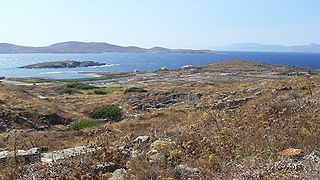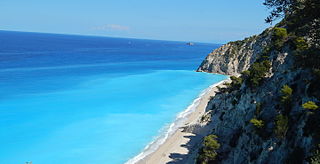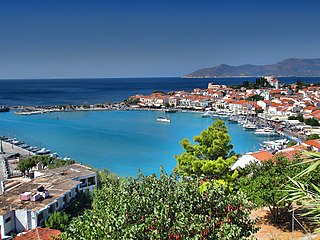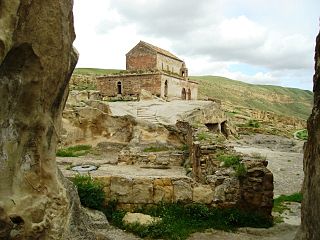
Salamis was an ancient Greek city-state on the east coast of Cyprus, at the mouth of the river Pedieos, 6 km north of modern Famagusta. According to tradition, the founder of Salamis was Teucer, son of Telamon, king of the Greek island of Salamis, who could not return home after the Trojan War because he had failed to avenge his brother Ajax.

The island of Delos, near Mykonos, close to the centre of the Cyclades archipelago, is one of the most important mythological, historical, and archaeological sites in Greece. The excavations in the island are among the most extensive in the Mediterranean; ongoing work takes place under the direction of the Ephorate of Antiquities of Cyclades, and many of the artifacts found are on display at the Archaeological Museum of Delos and the National Archaeological Museum of Athens.

Tourism in Greece has been a key element of the economic activity in the country, and is one of the country's most important sectors. Greece has been a major tourist destination and attraction in Europe since the 1970s for its rich culture and history, which is reflected in large part by its 18 UNESCO World Heritage Sites, among the most in Europe and the world as well as for its long coastline, many islands, and beaches.

Tongeren is a city and municipality located in the Belgian province of Limburg, in the southeastern corner of the Flemish region of Belgium. Tongeren is the oldest town in Belgium, as the only Roman administrative capital within the country's borders. As a Roman city, it was inhabited by the Tungri, and known as Atuatuca Tungrorum, it was the administrative centre of the Civitas Tungrorum district.

Tiryns is a Mycenaean archaeological site in Argolis in the Peloponnese, and the location from which the mythical hero Heracles was said to have performed his Twelve Labours. It lies 20 km (12 mi) south of Mycenae.

Epidaurus was a small city (polis) in ancient Greece, on the Argolid Peninsula at the Saronic Gulf. Two modern towns bear the name Epidavros: Palaia Epidavros and Nea Epidavros. Since 2010 they belong to the new municipality of Epidaurus, part of the regional unit of Argolis. The seat of the municipality is the town Lygourio. The nearby sanctuary and ancient theatre were inscribed on the UNESCO World Heritage List in 1988 because of their exemplary architecture and importance in the development and spread of healing sanctuaries and cults across the ancient Greek and Roman worlds.

Vergina is a small town in Northern Greece, part of Veria municipality in Imathia, Central Macedonia. Vergina was established in 1922 in the aftermath of the population exchanges after the Treaty of Lausanne and was a separate municipality until 2011, when it was merged with Veroia under the Kallikratis Plan.

Mtskheta is a city in the region of Mtskheta-Mtianeti, Georgia. It is one of the oldest cities in Georgia as well as one of the oldest continuously inhabited cities in the world. It is located approximately 20 km (12 mi) north of Tbilisi, at the confluence of the Mtkvari and Aragvi rivers. Currently a small provincial capital, for nearly a millennium until the 5th century AD, Mtskheta was a large fortified city, a significant economical and political centre of the Kingdom of Iberia.

Chersonesus is an ancient Greek colony founded approximately 2,500 years ago in the southwestern part of the Crimean Peninsula. Settlers from Heraclea Pontica in Bithynia established the colony in the 6th century BC.

Pontic Olbia or simply Olbia is an archaeological site of an ancient Greek city on the shore of the Southern Bug estuary in Ukraine, near the village of Parutyne. The archaeological site is protected as the National Historic and Archaeological Preserve. The preserve is a research and science institute of the National Academy of Sciences of Ukraine. In 1938–1993 it was part of the NASU Institute of Archaeology as a department.

Greek Crimea concerns the ancient Greek settlements on the Crimean Peninsula. Greek city-states first established colonies along the Black Sea coast of Crimea in the 7th or 6th century BC. Several colonies were established in the vicinity of the Kerch Strait, then known as the Cimmerian Bosporus. The density of colonies around the Cimmerian Bosporus was unusual for Greek colonization and reflected the importance of the area. The majority of these colonies were established by Ionians from the city of Miletus in Asia Minor. By the mid-1st century BC the Bosporan Kingdom became a client state of the late Roman Republic, ushering in the era of Roman Crimea during the Roman Empire.

Samos is a Greek island in the eastern Aegean Sea, south of Chios, north of Patmos and the Dodecanese archipelago, and off the coast of western Turkey, from which it is separated by the 1.6-kilometre-wide (1.0 mi) Mycale Strait. It is also a separate regional unit of the North Aegean region.

The Heraion of Samos was a large sanctuary to the goddess Hera, on the island of Samos, Greece, 6 km southwest of the ancient city of Samos. It was located in the low, marshy basin of the Imbrasos river, near where it enters the sea. The late Archaic temple in the sanctuary was the first of the gigantic free-standing Ionic temples, but its predecessors at this site reached back to the Geometric Period of the 8th century BC, or earlier. As a testimony to the mercantile and naval power of Samos during Archaic Greece, and its exceptional architecture, the site of temple's ruins, with its sole standing column, was designated a UNESCO World Heritage Site, along with the nearby archeological site Pythagoreion in 1992.

The Tunnel of Eupalinos or Eupalinian aqueduct is a tunnel of 1,036 m (3,399 ft) length running through Mount Kastro in Samos, Greece, built in the 6th century BC to serve as an aqueduct. The tunnel is the second known tunnel in history which was excavated from both ends, and the first with a geometry-based approach in doing so. Today it is a popular tourist attraction. The tunnel is inscribed on the UNESCO World Heritage List along with the nearby Pythagoreion and Heraion of Samos, and it was designated as an International Historic Civil Engineering Landmark in 2017.

Gamzigrad is an archaeological site, spa resort and UNESCO World Heritage Site of Serbia, located south of the Danube river, in the city of Zaječar. It is the location of the ancient Roman complex of palaces and temples Felix Romuliana, built by Emperor Galerius in Dacia Ripensis. The main area covers 10 acres (40,000 m2).

Pythagoreio is a town and municipal unit on the island of Samos, North Aegean, Greece. Before the 2011 local government reform, Pythagoreio was a municipality. Since 2019, it is a municipal unit of East Samos. In 2011, the town's population was 7,996. It is the largest municipal unit in land area on Samos, at 164.662 km2 (63.576 sq mi). It shares the island with the municipal units of Vathy, Karlovasi, and Marathokampos. The archaeological remains in the town, known collectively as Pythagoreion, has designated a joint UNESCO World Heritage Site with nearby Heraion.

Uplistsikhe is an ancient rock-hewn town in eastern Georgia, some 10 kilometers east of the town of Gori, Shida Kartli.

The Temple of Eshmun is an ancient place of worship dedicated to Eshmun, the Phoenician god of healing. It is located near the Awali river, 2 kilometres (1.2 mi) northeast of Sidon in southwestern Lebanon. The site was occupied from the 7th century BC to the 8th century AD, suggesting an integrated relationship with the nearby city of Sidon. Although originally constructed by Sidonian king Eshmunazar II in the Achaemenid era to celebrate the city's recovered wealth and stature, the temple complex was greatly expanded by Bodashtart, Yatonmilk and later monarchs. Because the continued expansion spanned many centuries of alternating independence and foreign hegemony, the sanctuary features a wealth of different architectural and decorative styles and influences.

Aizanoi, Latinized as Aezani, was a Phrygian city in western Anatolia. It was located at the site of the modern village of Çavdarhisar, near Kütahya, on both sides of the Penkalas river, c. 1,000 m (3,300 ft) above sea level. The city was an important political and economic centre in Roman times; surviving remains from the period include a well-preserved Temple of Zeus, a combined theatre-stadium complex, and a round building, probably a macellum, inscribed with a copy of the Price Edict of Diocletian. The city fell into decline in Late Antiquity. In 2012 the site was submitted for inclusion on the UNESCO World Heritage List.
























